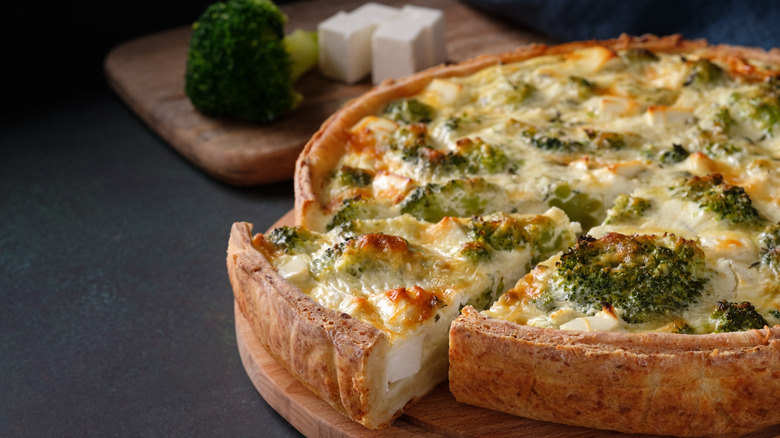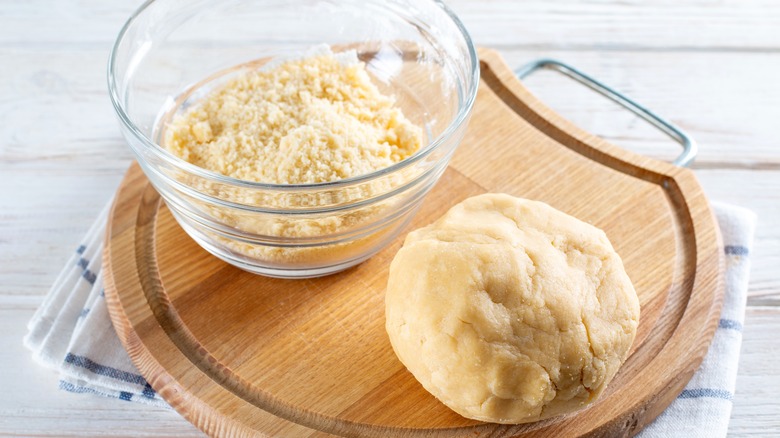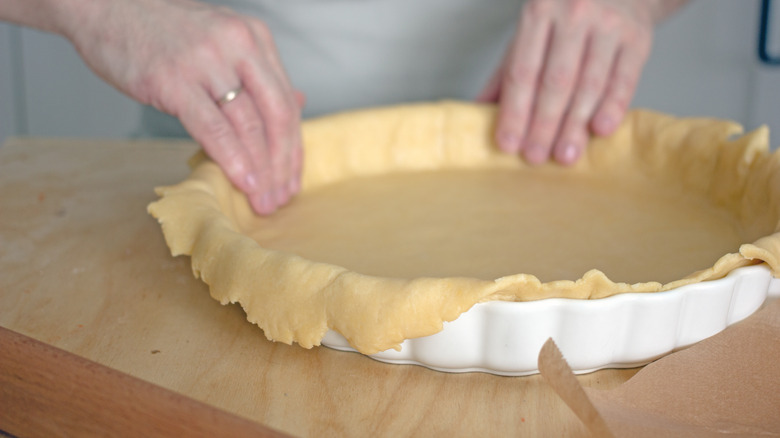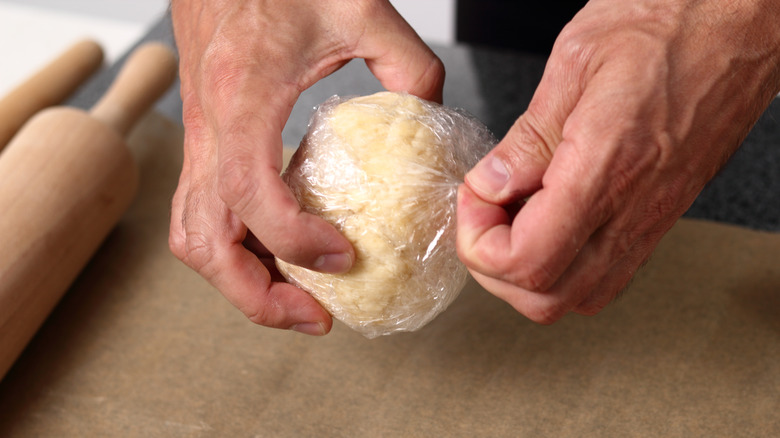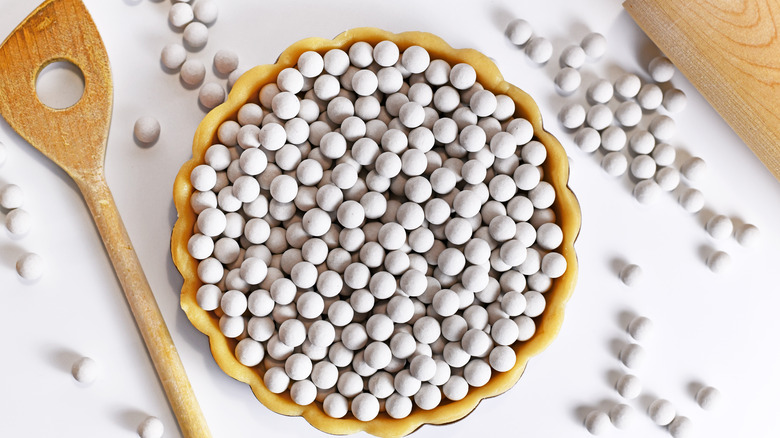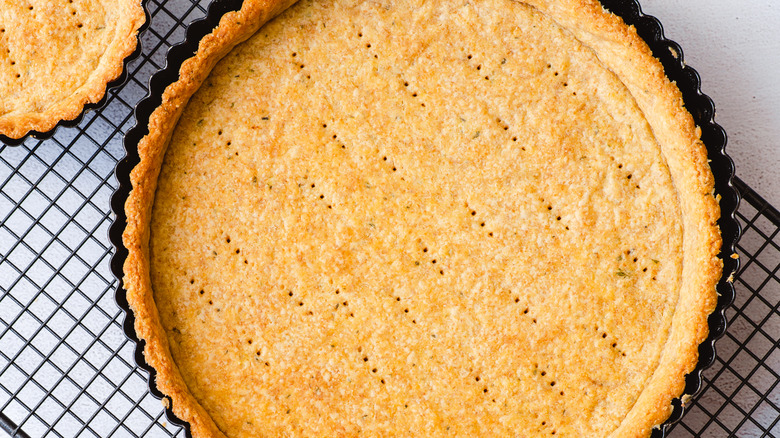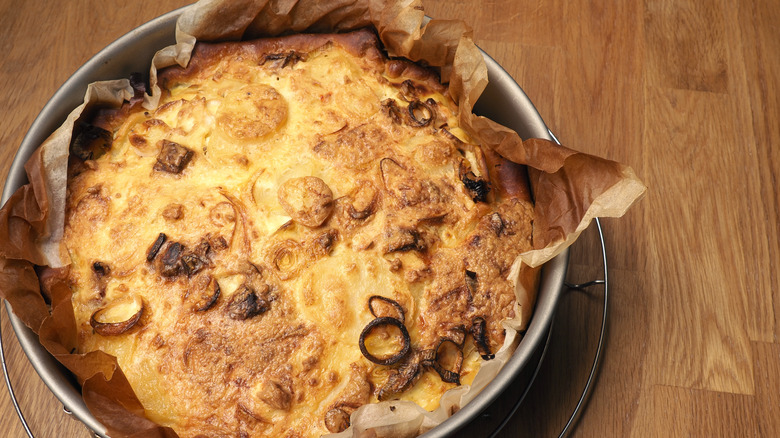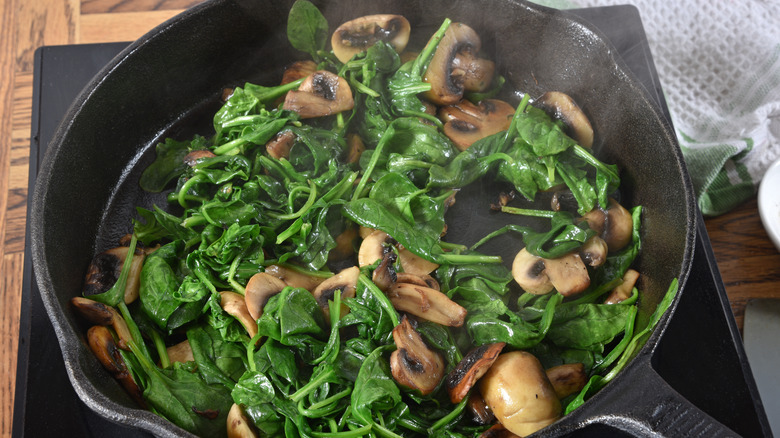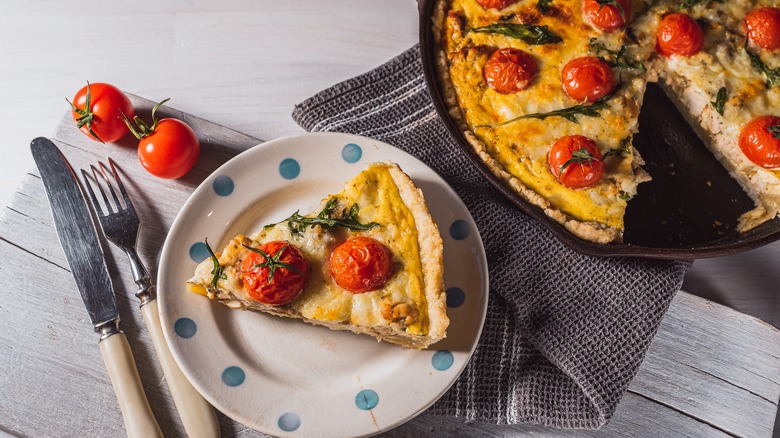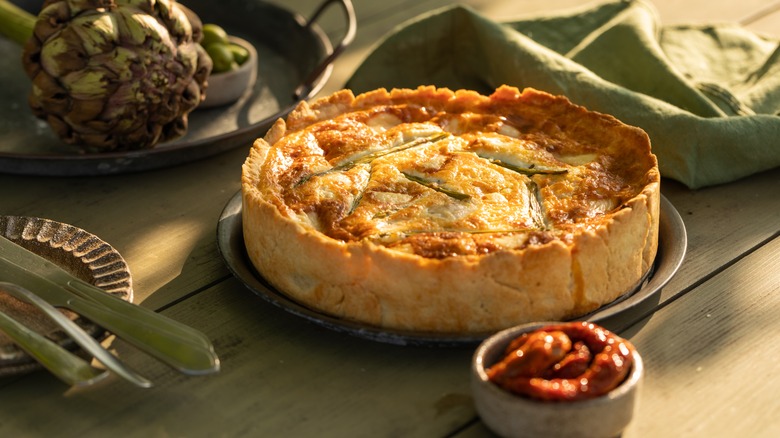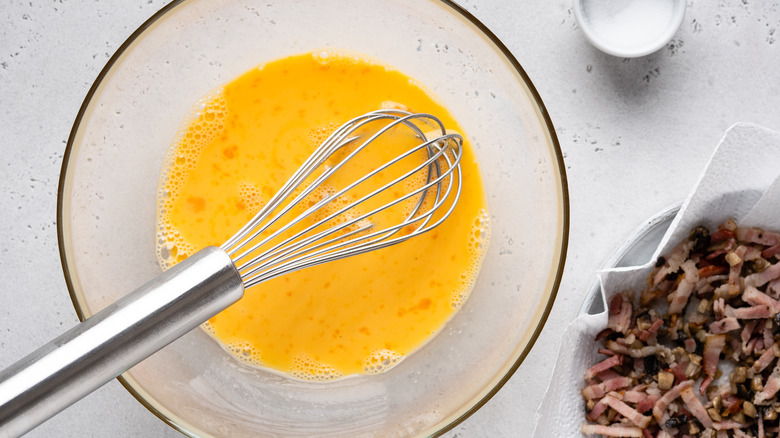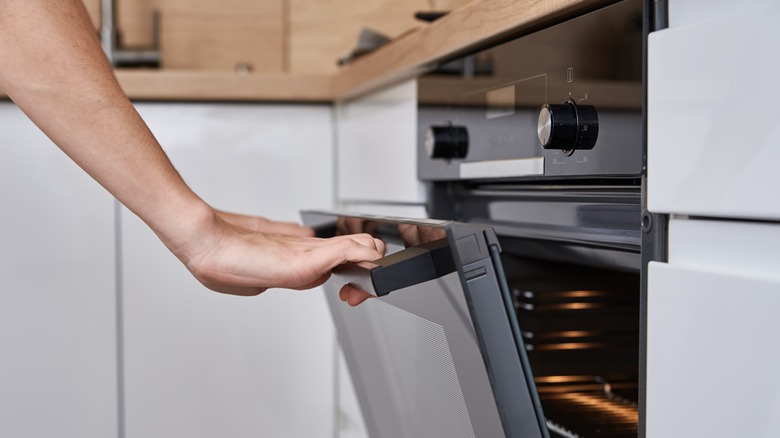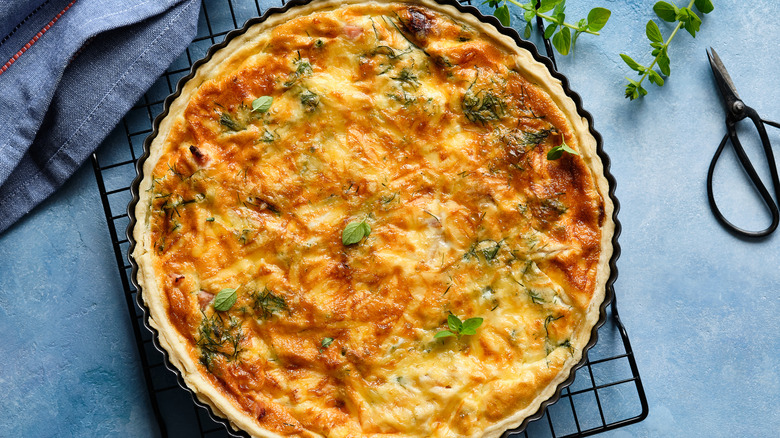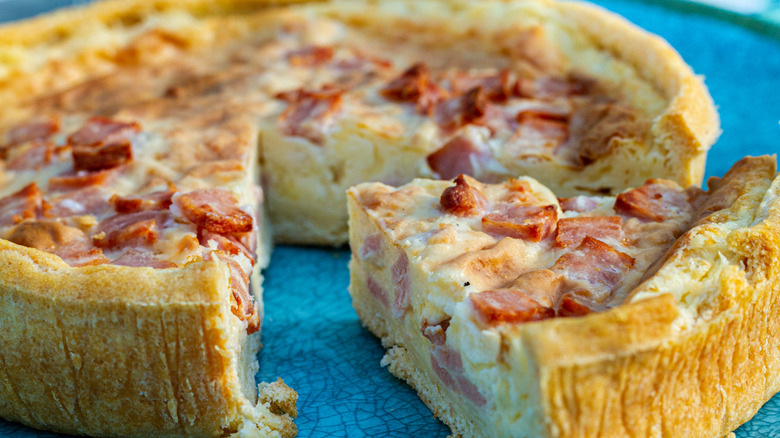The 14 Biggest Mistakes Everyone Makes When Cooking Quiche
The history of savory custard tarts goes back further than anyone can truly trace, but none have quite the esteem of quiche. Hailing from France, quiche has surprising German origins. It is believed to have been created in the 12th century in the German kingdom of Lotharingia (via Medium). The French word quiche even comes from the German word for cake, "kuchen." Despite the medieval beginnings, the modern quiche is most commonly associated with the Lorraine regions of France. The region is home to the iconic Quiche Lorraine, traditionally made with smoked bacon inside a custard tart. Quiche skyrocketed in popularity in the U.S. during the 1980s and 1990s, gracing many brunch tables. Now there are practically endless varieties of this quintessential French dish.
If you are daunted by making quiche, you are not alone. Making quiche can be an arduous process, and it's easy to fumble when making this pastry. To help you, we compiled people's most common mistakes when cooking quiches so you can become that confident quiche baker you've always dreamed of being.
Not using the right type of dough
Not all crusts are created equal. Choosing the best type of dough is a crucial step in making quiche. There are various types of pastry dough, but not all are well-suited for quiche. For example, pâte sablée, which is basically like a giant sugar cookie, is great for sweet tarts but would likely clash in a savory application.
The ideal crust for quiche is a shortcrust dough without too much sugar. A shortcrust is a crumbly pie or tart dough with a higher proportion of butter to four, typically two parts butter to one part flour. Shortcrust differs from very flaky doughs, such as laminated puff pastry, which is traditionally made with equal parts butter and flour.
In this no-mess Quiche Lorraine recipe, you can make an easy shortcrust using a food processor. This recipe has just ½ teaspoon of sugar, which won't result in an overly sweet crust. Be sure not to over-process your dough to get a tender crust. Using really cold butter is the key to getting the perfect pie dough. For best results, chill the butter in the freezer for a few hours before making your crust, and it won't melt by the heat of the food processor.
Not rolling out the dough properly
How you roll out your crust can hugely impact your quiche. Like other tarts, the thickness of your quiche dough matters. If it is too thick, you'll end up with too much crust in every bite. On the other hand, a crust that is too thin can easily lead to the filling leaking out during cooking. The best thickness for pie dough is the height of two quarters stacked together, which is about ⅛ inch thick.
To get a uniform bake on your crust, you must roll out the pie dough evenly. Rolling out dough on the counter can easily result in sticking. Alternatively, if you over-flour the dough while rolling, it will end up dry and brittle.
There is a simple trick to getting an even roll without sticking. Roll out the dough between two sheets of lightly floured parchment paper, taking care not to overwork the dough. Do not apply a ton of pressure to the dough, and repeatedly roll in the same pattern. Instead, start with your pin in the center of the dough and gently roll outward and then from the center towards you. Give the dough a quarter turn between every roll, and you will end up with an even crust without overly activating the gluten.
Not chilling the dough
When making any tart, keeping the butter cold is of absolute importance. Not only do you need to start with cold butter, but you need to keep it cold until the crust hits the oven. You may have heard you should chill the dough, but did you know you need to double-chill pie dough?
Even when you use the freezer trick to start with ice-cold butter, the process of making the dough will warm up the butter. If you roll out the dough immediately, you run the risk of activating the gluten. Butter contains water, and liquid activates gluten, so it is important to keep that butter cold throughout.
After making your dough, flatten it into a disc and cover it with plastic wrap in the fridge. Chill the dough for at least 30 minutes or up to overnight. The second chill comes after you roll out the dough. Again, this can warm up the butter. Once the dough is secured in your baking dish, chill for at least another 30 minutes before baking.
Not blind-baking the crust
One misconception about quiche is that because you bake the filling for a while, you can put the crust and filling in the oven together raw. This would be a huge mistake. You should always pre-bake quiche crust. This process of baking a pie or tart dough without the filling is called blind baking.
What happens when you do not pre-bake the crust? The custard filling will seep into the crust, locking in moisture. No matter how long you bake, you won't get a crisp crust — you'll end up with that dreaded soggy bottom that bakers fear.
To blind bake, line your tart shell with parchment paper and fill it with something heavy such as pie weights or dry beans. This helps prevent the crust from puffing up during baking. First, bake the weighted crust at 350 F for 20 minutes, then remove the weights and bake for another 10 to 15 minutes. If you do not have any weights on hand, Stella Parks suggests a trick where you use granulated sugar as the pie weight. You can even reuse the sugar three or four times. Parks notes that the sugar will develop a nice toasty flavor that's great for desserts like meringues.
Not brushing the crust with an egg wash
Now that you have blind-baked your quiche crust, you may think you are ready to add your filling. However, there is another step you need to take to help prevent a soggy bottom — you need to brush your pie crust with egg white. This egg wash will act as a protective layer between the crust and the filling.
When your pre-baked crust is still piping hot, brush the inside of the crust with a lightly beaten egg white. The residual heat will cook the egg and essentially seal the crust. This will help prevent the liquid filling from leaking through the crust, keeping it nice and crispy, and especially beneficial if any cracks form in the crust during baking. By taking this quick measure, you will no longer have to worry about opening the oven to find that your filling has leaked everywhere.
Choosing the wrong baking dish
Quiche is basically a savory pie, so you should bake it in a pie pan, right? That would be another major error. You should never bake quiche in a pie pan, and here is why.
The short answer is that standard pie pans are not deep enough for quiche. Your best option is a two-inch deep springform pan. Not only will you get the desired height, but your quiche will bake more evenly, and you'll be able to remove the quiche and slice with ease. If you do not have a springform pan, go for a two-inch high metal pastry ring instead of a pie dish.
This is not to say you cannot use a pie pan, and you will certainly see quiches all over the Internet baked in pie pans. However, most quiche recipes will create too much filling, and your dish will overflow with extra custard. When possible, opt for a different vessel and only use pie pans if that is all you have.
Not pre-baking the vegetables for the filling
Making quiche is not a quick venture, but it is important not to skip any steps in the process to try and save time. Imagine spending hours making the perfect-looking quiche only to bite into it and find the vegetables are still crunchy. This would probably be due to putting raw vegetables in the filling.
Since most veggies take longer to cook than the custard, you should pre-cook the vegetables for your quiche filling. This is your best bet for an evenly baked pastry. Sauté vegetables like onions, mushrooms, and spinach, while veggies like broccoli are best roasted or steamed. This will not only prevent too crunchy of a bite, but it helps release moisture from the veggies, which can ruin your filling.
On a similar note, it is also best to pre-cook meats for your quiche. Meats like bacon and sausage contain a lot of fat, and you won't want a pool of grease forming in your quiche. Pre-cooking the meats will allow for better flavor development through browning, and you will render out the fat, giving you control of the grease level.
Using fillings that are too wet
Vegetables contain a lot of water. Some vegetables, like cucumbers, lettuce, and celery, are made up of more than 90% water (via SF Gate). You've probably never heard of a cucumber quiche, and for a good reason. If you are finding yourself with soggy quiche, it may not be an issue with your crust or a matter of under-baking. Using vegetables with too much water will lead to a soggy quiche.
Avoid waterlogged vegetables in your filling. With vegetables, avoiding all water in your filling is nearly impossible, but you can take steps to get rid of as much liquid as possible. Greens like spinach give off a lot of moisture. After cooking, press the spinach to drain off the excess water. If you are going to use highly liquid vegetables, like tomatoes and zucchini, make sure to follow our advice of pre-cooking them. Slices of raw tomato may look beautiful, but they will make your quiche look under-baked.
Using the wrong combo of flavors in your filling
You may be a fan of both pepperoni and broccoli, but that doesn't mean they belong together in a quiche. When deciding what to put in your filling, aim for ingredients that pair well together. You can never go wrong with the classic Quiche Lorraine, a traditional French quiche with bacon, onions, and gruyere. Other classic flavor combinations are ham, cheddar and broccoli; goat cheese and mushroom; spinach, red peppers, and feta; and smoked salmon and asparagus.
There are endless possibilities for quiche fillings, but be careful not to go overboard. Stick with just a few ingredients to add to your custard. The more elements you add, the more likely you will get clashing flavors. Simple flavor pairings are the way to go.
It is also good to consider the season when picking your filling. Playing to the seasonality of vegetables can greatly improve your quiche. A butternut squash quiche would be a great choice in the fall, while this spring quiche recipe would work well in the spring when green vegetables like leeks, spinach, and arugula are in peak season.
Using the wrong egg-to-cream ratio
Quiche is a savory custard tart. The wrong number of eggs can absolutely ruin your brunch. You can choose the absolute best ingredients for the filling, but if your egg-to-cream ratio is off, you won't get the luscious texture you expect in a quiche. The eggs are essential in creating the custard's texture. Too many eggs will make your filling feel rubbery and tough, but too few eggs will leave you with a runny custard that won't set. So how many eggs should you use for quiche?
The good news is you do not have to be a mathematician to make this pastry. The correct ratio for a quiche custard is one egg to one-half cup of cream or milk. For a standard nine-inch quiche, your custard should contain roughly three eggs and one and a half cups of liquid. Follow this formula, and you'll have the ideal creamy and velvety mouthfeel.
Baking on the top rack
You've spent all this time and effort prepping your quiche, and the last thing you want to do is mess up the baking. A properly baked quiche begins with the oven position. You might not stop to consider oven position very often, but it can make a big difference in your baking.
The versatile middle rack is probably the most commonly used in everyday cooking. It is evenly spaced between both heat sources in your oven. The bottom rack sits just above the oven's heating element, while the top rack is just under the broiler in most ovens. The bottom rack is ideal for making pizzas and crusty bread. The top rack is great when you want to brown the top of your dish, such as garlic bread or casseroles.
The best spot in the oven to bake quiche is the bottom rack. Being close to the heating element will help the crust brown while allowing for an even bake throughout the custard.
Baking at the wrong temperature
A lot of pie recipes call for higher baking temperatures, as much as 425 F, but quiche needs different handling. Too high of a temperature could destroy your perfectly crafted custard tart. Some quiche recipes will instruct to bake at 350 F to 400 F, but we highly advise against this. That range is too high for this dish. If you have ever noticed your quiche filling get puffy (almost like a soufflé), high chances are your oven was too hot. Your filling should have a velvety consistency instead of too eggy.
The best oven temperature to bake quiche is 325 F. If you blind-baked your crust at 350 F, make sure to lower the oven temperature before baking the filling. This lower temperature will give you a tender, creamy custard instead of one that is dry and over-baked. This will also help prevent the top from browning too much or even burning before the center is cooked.
Baking the quiche for too long
Here's a little-known secret. You should under-bake your quiche. While this may seem counterintuitive, paying close attention to a few cues will save you from an over-baked custard.
It's difficult to give a broad recommendation for cooking times. Pan size and heat differences in various ovens can impact how long it will take your quiche to cook fully. In general, most quiche recipes will call for baking for at least 1 hour (about 60 to 75 minutes).
Air on the side of under-baking. Put it out of the oven when the custard looks mostly set but still has a little jiggle in the middle. It will continue to cook through in a process known as carryover cooking, coming to the proper consistency by the time it cools. If you are still uncertain when to take the quiche out of the oven, use a probe thermometer. The center should read between 175 and 180 degrees.
Not letting the quiche rest
Believe it or not, letting your quiche rest is considered part of the cooking process. As tempting as it may be to dig into your masterpiece right away, you need to practice patience.
It's important to fully cool your quiche before consuming it. First, the residual heat will finish cooking the quiche in the center. If you eat too soon, the eggs might be undercooked in the middle. Second, allowing the quiche to cool fully instead of eating it after 20 minutes will ensure that the custard has time to be fully set. Some chefs will even suggest baking the quiche the day prior to serving for the best custard texture. At the very least, let it sit for an hour before serving.
While this type of tart tastes great at room temperature, there are a few ways to best reheat quiche. Reheat the quiche in the oven at 350 F for 10 to 20 minutes. Alternatively, you can heat individual slices in your air fryer set at 300 F for 4 to 7 minutes, but be careful not to leave it in too long, or it may dry out. Finally, you can always use the microwave, although this should be avoided as this method can easily turn quiche rubbery. To prevent this, use 50% power and cook for 2 to 3 minutes and then in additional 30-second intervals. No matter your method, make sure the quiche comes to room temperature before reheating.
